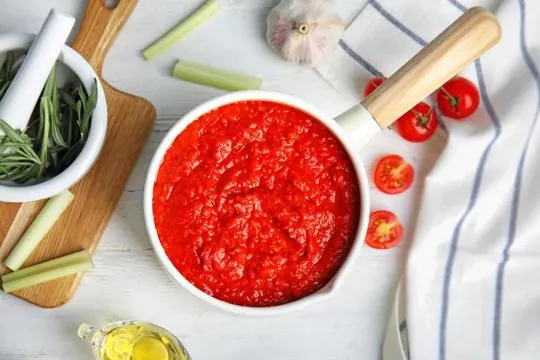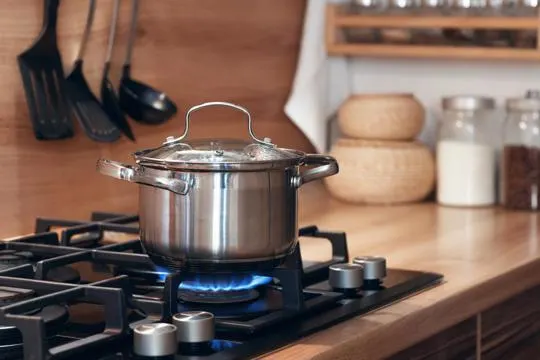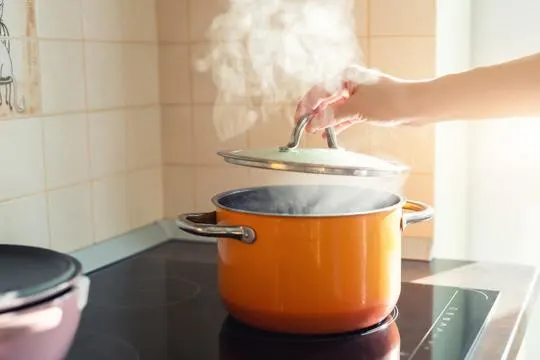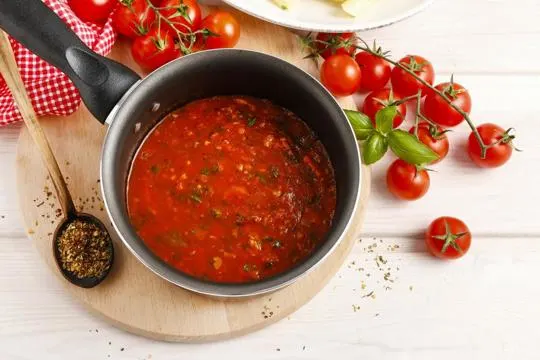Summary of key points
The main difference between a saucepan and pot lies in their size and intended use. A saucepan is smaller with straight sides and a long handle, making it perfect for making sauces, cooking grains or pasta, or heating up small portions of food. On the other hand, a pot is larger with sloped sides and two handles, making it ideal for boiling water, cooking soups or stews, and making large batches of food. Both are essential for any kitchen as they serve different purposes, so it’s worth having both on hand to tackle all your cooking needs! Experiment with different recipes to see which one you prefer for specific dishes.
Ever stood in the kitchen, saucepan in one hand, pot in the other, puzzled? We’ve all been there.
It turns out, these kitchen staples aren’t as interchangeable as we might think.
Sauce pans are the ninjas of the sauce world. Small, yet mighty. Pots? They’re the heavy lifters.
Our experiences? A saucepan saved a dinner date. A pot, well, it hosted a catastrophic pasta party.
We’re here to break it down. Step by step, no culinary degree required.
Think of us as your kitchen guides, minus the fancy hats.
What is a Sauce Pan?

A saucepan is a handy kitchen tool. It has a deep, straight-sided design with a long handle.
The size can vary from small to large. What sets it apart from a pot is its shape and size.
Pots are wider and deeper than saucepans. But they both cook similar dishes.
Pots are better for cooking a lot of food or stirring ingredients.
Saucepans distribute heat evenly.
This is great for delicate dishes that need precise temperature control.
Its narrow opening stops evaporation and helps control liquids.
Another great thing about saucepans is that you can use them on various stovetops.
Gas, electric, ceramic, or induction – this tool can do it all.
Making it an essential for any kitchen.
What is a Pot?

Pots are must-haves in most kitchens. They are multi-functional and can be used for boiling, stewing, and simmering.
With their deep shape and handles, pots are great for cooking large amounts of food.
Different materials are used to make pots, such as stainless steel, aluminum, cast iron, copper, and even non-stick coating.
Each material has its own pros and cons. You can find pots of all sizes for any recipe.
Smaller ones are great for heating sauces, while larger ones are perfect for soups and pasta dishes.
Some even come with lids to help keep heat and moisture.
Pots are special because they distribute heat evenly across their surface, so food cooks perfectly.
Also, the thicker bottom helps retain heat.
No matter if you’re an amateur or a chef, having a pot in your kitchen is invaluable.
It’s durable and can handle daily cooking.
Key Differences Between Sauce Pans and Pots

Sauce pans and pots may look alike but they are different.
Both are key cookware items, each suited to different cooking tasks.
Design and Shape
Sauce pans and pots may look akin, but they differ.
Sauce pans have tall sides, a small diameter, and are ideal for liquids and sauces.
The narrow opening of a sauce pan traps heat to cook evenly.
Pots, however, have shorter sides, a wider diameter, and are great for larger ingredients and browning.
Plus, both come in various sizes to suit all cooking needs.
So, when choosing between the two, it all depends on what you plan to cook.
This way, you can make meals with accuracy and no compromise on taste.
Usage and Functionality
Kitchens need sauce pans and pots. They serve different jobs in cooking.
Sauce pans are smaller. They have a long handle plus lid.
They’re great for simmering, soups, or other delicate ingredients.
The sides help stop splattering and let you stir without spilling.
Pots are larger. They have two handles.
They’re useful for boiling pasta, veggies, stews, stocks, and big one-pot meals.
Sauce pans have a special design for good heat conduction and retention.
Usually, they have stainless steel, copper, and aluminum layers.
So heat spreads evenly over the entire pan.
Both sauce pans and pots are practical.
Sauce pans are good for precise heating and small amounts. Pots help make big meals.
Understanding which does what will get you the right cookware.
Cooking Techniques
Every cook knows that mastering techniques is essential to becoming a chef.
These techniques boost the taste, texture and presentation of the dish.
Sautéing, braising, grilling, poaching, steaming, roasting, and baking are all cooking techniques.
Each has its own set of skills and tools.
Knowing the differences is important for great results.
Sautéing involves quickly frying in oil or fat over high heat.
It’s great for vegetables or small cuts of meat.
Braising is a slow-cooking method for tougher meat.
Brown the meat, then simmer it in liquid until tender.
The flavors mix together. Grilling is for smoky flavors.
Gas or charcoal grills require precise timing and temperature control.
Roasting brings out the natural sweetness of food when cooked uncovered in the oven.
Steaming lets ingredients keep color, texture and nutrients.
Mastering cooking techniques impresses as a chef and adds to the dining experience.
Have fun experimenting and enjoy the artistry of cooking.
Common Features Shared by Sauce Pans and Pots

Sauce pans and pots: two kitchen must-haves.
Both have deep, round bottoms for even heat distribution and non-sticking.
Their long handles and lids help to trap heat and moisture.
This makes them perfect for any recipe and cooking technique.
Sauce pans are smaller with straight sides. Great for heating liquids or sauces.
Pots are larger with sloping sides. Perfect for soups, stocks, or pasta dishes.
Different materials available like stainless steel, aluminum, or cast iron.
Each has its own advantages and disadvantages.
Plus, some models have non-stick coatings or glass lids.
So, sauce pans and pots.
Common features for successful cooking.
Unique characteristics for different needs.
Have both and you can tackle any recipe with ease.
Delicate sauces or hearty stews – these cookware options will deliver.
Factors to Consider When Choosing Between a Sauce Pan and a Pot
When it comes to cooking the perfect meal, having the right tools in the kitchen is essential.
One of the most important tools is deciding whether to use a sauce pan or a pot.
While both can handle a wide range of cooking tasks, there are some factors to consider to ensure that you’re using the right tool for the job.
Firstly, sauce pans are ideal for delicate tasks such as making sauces or reheating leftovers.
Their smaller size and curved sides make them perfect for heating liquids without burning.
Pots, on the other hand, are better suited for cooking one-pot meals or soups.
They are deeper and have a wider base, allowing you to cook larger portions without running low on space.
Ultimately, the decision between a sauce pan and a pot comes down to your specific cooking needs and the type of dish you’re making.
Size and Capacity
Size and capacity are two crucial elements to take into account when selecting between a saucepan and pot.
Both kitchen tools have similar functions, however, they differ in terms of their measurements and volume.
Saucepans are usually more diminutive in size than pots.
They are intended for culinary jobs that require smaller amounts, such as heating sauces or simmering soups.
With a smaller circumference and height, saucepans are ideal for exact cooking.
Their minor size also makes them simpler to store in congested kitchen cupboards.
On the flip side, pots present bigger capacity due to their bigger dimensions.
They are perfect for cooking larger portions of food, like stews or pasta.
Pots offer enough room for ingredients to cook equally and permit space for stirring and mixing without spillage.
Their generous quantity makes them suitable for preparing meals for huge gatherings or families.
Apart from the difference in size, saucepans and pots may also differ in shape.
While most saucepans have straight sides, some pots have flared sides that assist in evaporation during extended cooking processes.
Cooking Surface Material
What you use for cooking can affect your experience.
Different materials have varying conductivity and temperature control.
Saucepans and pots require careful material selection.
Stainless steel is good for acidic ingredients, but not the best at heat conductivity.
Copper is great for quick heat distribution, but expensive and needs regular maintenance.
Cast iron is tough and retains heat well.
It can be used on multiple heat sources like stovetop or oven.
But it takes longer to heat up. Non-stick surfaces are convenient for low-fat cooking.
But they don’t handle high temps or metal utensils well. Over time, they can be damaged.
Handles and Lid
The right handles and lid on your kitchen cookware can make a huge difference.
They should provide a comfortable grip for easy maneuverability when stirring, tossing or pouring.
Plus, a sturdy lid helps trap heat and moisture, improving the flavor of your dishes.
Saucepans and pots have different handle designs.
Saucepan handles are long, securely riveted or welded to the pan’s body.
This helps with balance and control.
Pot handles are side handles, providing a secure grip when lifting or moving.
Saucepan lids are usually tight-fitting with a small vent hole for steam.
This helps retain moisture while simmering sauces or stews.
Pot lids are larger, sometimes with a built-in strainer feature.
These are great for larger quantities of food or tall utensils.
It might seem trivial to choose between a saucepan and a pot based on their handles and lids.
But having comfortable cookware can really improve your cooking.
So, opt for a saucepan with its long handle or a pot with its sturdy side handles.
These details can take your cooking prowess from ordinary to extraordinary.
Versatility and Best Uses of Sauce Pans and Pots
Sauce pans and pots are must-haves in the kitchen. Let’s find out what sets them apart.
Sauce pans are great for melting butter and making custards.
They have a wide base which guarantees even heat distribution and no hot spots.
Plus, the straight sides mean sauces can be simmered and liquids can be reduced.
Pots, on the other hand, are designed for larger quantities and heartier dishes.
Their high sides are ideal for boiling pasta or cooking soups and stews.
The spacious interior allows for easy stirring and the perfect combination of flavors.
Both sauce pans and pots are versatile.
Sauce pans can double as small frying pans and are great for sautéing veggies or searing meats.
Pots can be used to braise meat or cook rice in large batches. The size of the cookware also matters.
Smaller sauce pans are great for tasks that need control, while larger pots are the way to go when feeding a crowd or making one-pot meals.
Conclusion
In conclusion, it all comes down to the difference between a sauce pan and a pot.
Pots are larger, heavier, and designed for longer-cooking dishes such as soups and stews.
Sauce pans are smaller, lighter, and designed primarily for boiling liquids or preparing sauces.
There is no one-size-fits-all answer when choosing between pots and pans – the right type of cookware will depend on the meal being made.
Be sure to pay attention to the materials it’s made of – you’ll want something durable that can withstand tough temperatures while still holding up for years to come.
Don’t forget about size.
Go with something that matches your needs but won’t take up space in a small kitchen; look for items with an integrated pouring spout or pour lip for easy dish draining.
Ultimately, you’ll have to choose the option best suited for your cooking style over the one boasting the biggest discounts or shiny finish.
With this guide in hand, now you know how to make informed buying decisions next time when browsing pots and pans.

Leave a comment